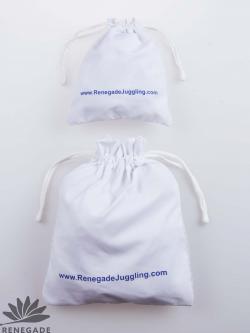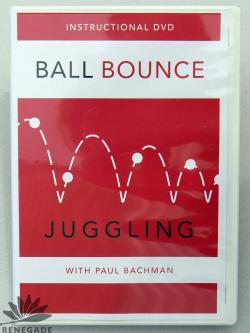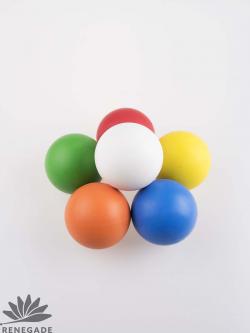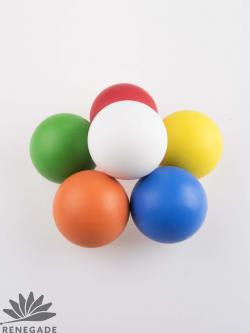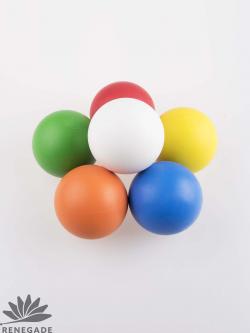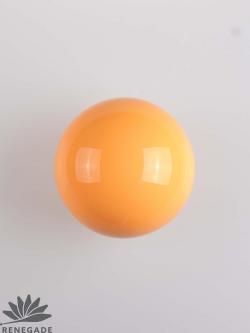Silicone Bounce Balls
Renegade juggling offers silicone juggling balls, made in Holland, by Spotlgiht. These ball are made using the same high quality silicone as the top USA brands, the Fakini formula. The use of this silicone compound was developed in the 1970's by Frank Radtke. Many other prop makers have tried to duplicate the feel and bounce of this original compound with other substitute (cheaper) silicone/rubber compounds, but have unable to do so. The Fakini silicone ball remans the best on the market.
Silicone is resistant to staining, any soiling just wipes right off. Each ball is meticulously molded by hand with no fill marks. Unequaled bounce and resilience. For uncompromising quality and peak performance, silicone juggling balls are a great choice.
Three sizes 70mm (2.75 inch) 64mm (2.5 inch) and 61mm (2.4 inch)
To help you select the correct size of juggling balls, look at our Juggling Guide and Tips section listed in the bottom footer of the home page.
/juggling-guides-tips/how-to-select-a-juggling-ball-size/
Frank Radtke of Toledo, Ohio, invented the silicone ball in about 1970 in pursuit of a better prop for magicians like himself.
Magic was always his sideline passion, while toolmaking at a plastics plant kept he, Joyce, and six children fed, clothed and sheltered. Following Radtke's first-shift job at Modern Tools division of LOF, he would come home to tinker in his cluttered garage workshop on props for himself or other magicians.
On an occasion at Abbotts Magic Shop in about 1968, Radtke heard a friend despair that a certain type of sponge rubber golf ball used in a trick was no longer available. Radtke decided he was up to the challenge and started building molds in his shop and filling them with silicone, a material he was very familiar with from his day job. After two years he figured he had it right, and sent out his first set of dimpled silicone golf balls. The trick in question employed a ball that fit in an outer half-shell so that a single ball could become two with a skillful manipulation. Silicone turned out to be a good material for the prop because it was tacky and easy to handle.
The first person to use silicone for the art of juggling was apparently Eddie Rosto, a Dutch juggler who picked up a set of Radtke's multiplying golf balls in a magic shop in Holland. On a visit to America Rosto asked for a larger size version to juggle, and Radtke made some new molds for shell-less, smooth balls. Rosto was so pleased with the product that he dubbed them "fire bouncers."
Radtke was utterly unaware of how far the ripples of his work would spread in the juggling community. "I never realized the value of these balls for jugglers because I'm not a juggler myself," he said.
But Radtke's multiplying golf balls were appearing in magic stores, and some began to find their way into the hands of jugglers. Gil Dova was another early customer. While performing in Geneva, Switzerland, in 1976, Dova saw one of Radtke's bright orange silicone golf balls in a magic store. He, too, liked the way it felt and wished he could have a juggling ball of the same material. It had to be a perfect size to fit through a hole in a rigged suitcase which shot balls up to Dova in his act.
Dova said, "So I wrote Frank and asked if he could make them larger and white. He said it was possible, but he'd have to make a bigger mold. I told him to go ahead, and sent him some money. They were terribly expensive because I was paying for the molds and everything. But I got them and they were terrific! I've never used lacrosse balls in the act since. They bounce so much better, they don't get dirty and they're so white. You could never get lacrosse balls to stay that white."
Understanding now that there might be a market among jugglers, Radtke built more molds and began selling his balls for up to $50 each. They were bought first strictly by professional entertainers who could afford that kind of money for a tool of the trade. Besides Rosto and Dova, Radtke said Dick Franco, Rudy Schweitzer, Paul Bachman, Michael Moschen and Phillipe Petite were among his early customers.
Radtke was surprised to find that his silicone balls were treated with some awe and reverence. He sold a set to Ringling Clown College, but heard a couple of years later they had disappeared from the school. Meanwhile, he got a letter from France requesting information about the balls. The writer had been referred to Radtke by a former Ringling Clown College instructor. Still later, he met Arsene, who was carrying a set of Radtke's balls he said he got from that same instructor. Radtke said, "I don't know whether the instructor walked off with them or got them through another agreement. Anyway, I was surprised and happy to know people would keep track of them that closely."
Dick Franco was using Radtke balls when he beat Rudy Schweitzer in a televised juggling competition. Radtke soon thereafter got an order for silicone balls from Schweitzer. "I don't know for a fact, but I'm speculating that Rudy thought they might have given Dick an edge," said Radtke.
Franco recalls quite well how he came to discover silicone balls. "I saw Gil Dova in 1978 in Blackpool, England, and he showed me these great balls he had. I immediately wrote to Radtke and ordered 10 of them. They were incredibly expensive because he had to make a new mold in my size. I had been using big 3-1/16" dog balls and wanted the same size. I paid $500 for the first one and $50 apiece after that. Then I ruined 5 of them by sanding them. I didn't like the way they felt. I sold them to someone and got myself some more."
Franco has always been willing to pay the price primarily because of how silicone responds when he puts "English" on the ball. "People never expect it's going to jump like that," he said. "I toss it stage left on a trajectory where it'll wipe out the whole front row, and you can see the people cringing. But then it jumps back to me with great effect. So I do it again and again, a little farther and little longer each throw. It always gets a big applause. No other ball will jump back to you like silicone. I've changed my act in several ways to accommodate them."
Radtke continued in the cottage industry tradition, working largely from his heart. He said, "With six children, I couldn't afford to advertise. I always figured silicone balls were too expensive and no one would buy them except a few people. I'm just not a marketeer. The potential may be there but I'm not the one who's going to tap it."
Brian Dube said he first saw Radtke's silicone balls at the 1979 IJA convention in Amherst. Friends urged him to manufacture them and he began experimenting with the manufacturing process. But it took him until 1984 to finally get the product in his catalog and on the market. He said, "I gave up at various points, and finally discovered independently how to make them. To get balls that are defect-free is the main challenge. This stuff is very finicky. We introduced them into the juggling community through advertising and our catalog."
Todd Smith said he began selling silicone in the summer of 1983, also after a great deal of tinkering and frustration with rejects. Smith explained, "When they first came out they were hard to sell. Lacrosse balls were the first choice and it was hard to sell something that cost 10 times that much. I used to get requests for seconds all the time, but now I almost never do. As far as balls go, people have decided there's nothing better."
The first property most people praise in silicon is its bounce. But manufacturers point out it is not overly superior. Smith said, "A silicone ball will bounce back about 75 percent, but a lacrosse ball gets 70 percent."
Dube said, "Secondary properties are more the issue than the bounce. You can pigment the silicone and get very bright colors, and the colors don't deteriorate substantially over time. Silicone withstands light, heat and atmospheric conditions. Silicone resists soiling and maintains its finish. The material is very inert and inactive, which is why they can use it in the human body. Silly putty is a form of silicone.
"But I also espouse a theory that the cost far outweighs the benefit, and that's where it becomes a status thing. There is always a certain strata who are willing to pay for a sports car rather than a sedan, though both will get you there just as well. Silicone has become a cult thing, almost a fad, simply because it's very expensive."
Radtke is no different from the other makers in jealously guarding his ingredients and process. He said he uses the same silicone material that forms artificial heart valves, and that it costs him $18 a pound. He builds his own molds, and that saves a tremendous amount of money. "Besides the silicone, I add about five special ingredients that I won't divulge. And I experimented with about 50 different pigmentations before I found the one I like. You put it all in a mold and it cures overnight. But I can't tell you anything more specific than that."
The biggest challenge faced in the manufacturing process is to avoid air bubbles. Radtke said he worked for two or three years to overcome that problem. He's also proud that his balls have no visible "sprue" or "vent" spots. They do have seams, though, because he said, "you can't make a ball without a seam."
Though he runs a small shop, Radtke has some advantages that Dube and Smith cannot match. First of all, he has molds to produce balls in nine sizes, from 3/8" all the way to 3-1/16". He has also devised a process to incorporate a juggler's initials, or other design, permanently into the surface of the ball during its manufacture. Paul Bachman, who got the first batch of Radtke's initialized balls, pointed out the utilitarian value of that feature. He said, "It's a silicone ball world out there now. With everyone having a set, you can keep track of your own in a crowded gym when your initials are right there in the ball."
While he doesn't exactly resent the fact that Dube and Smith have become the mass marketers of the product he invented, Radtke follows a code of ethics that takes the others to task for him. He said, "I got permission to put the diminishing golf ball on the market after its original inventor, Laurie Ireland, died. I didn't have to get permission, but I do everything as ethically as possible. A silver extraction coin I make was originated by a dentist, Doc Zola. When a guy told me he wanted one and Doc wasn't making them anymore, I made one for him. But first I showed it to Doc and asked him if I could make them. He said I could, and I made it better than he did.
"Let's just put it this way, if I knew someone was making silicone juggling balls, I wouldn't have made them, too. I'm not resentful, but sometimes I feel hurt. But they're in business to make money and I suppose that's what they do. Fortunately I don't have to earn my living doing it."
He said he never even considered trying to patent a silicone ball because a friend in the magic business called patents "an invitation to a law suit," and not worth the trouble unless the product had a potential for huge sales.
So, under the business name of "The House of Fakini," he remains as a small-time producer of silicone juggling balls and a few other magic props. He says the balls are only 10 percent of his small business, that the majority is multiplying golf balls, billiard balls and flowered items. He performs magic occasionally around Toledo. His performing name, "Fakini, the Fat Fabulous Fascinator," is to make sure no one is surprised at what they have hired when he shows up for a performance at 340 pounds - after losing 70!
All three manufacturers say that despite their high price, silicone balls are not a big profit maker. The raw material is expensive, they're labor intensive, and you can only make a few at a time. Radtke says his chief reward for his ground-breaking effort has been new friends in the juggling community. "I really enjoy talking to jugglers, and have met a lot of them by making these balls," he said.
by Matthew Love on 04/30/20
Love the colors and the bounce of these silicone balls. Worth the price.
by Zeke Farley on 06/22/20
by Steve Olechna on 12/06/21
Renegade's silicon juggling balls have been a great addition for my performances at elementary schools, senior groups, and most recently a company fundraiser. See YouTube link: arthttps://www.youtube.com/watch?v=lI14smbA6ns
Love all the Renegade products. First purchased from Renegade in the 1980's! Still use those clubs!
by Don Weinhouse on 01/22/24
by N. Dorrell on 09/26/24
If you have never experienced these balls...you haven't juggled! They are the world's best! I wanted other colors but settled for white and I am glad I did! They make the juggling look amazing! Best bounce juggling balls in the world for real! The grip is wonderful...if you've tried the g-force or other compressed rubber balls, these far exceed in their grip and feel. You will never juggle rubber balls again if you make the plunge--the cost is worth it!

